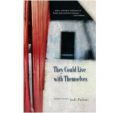An oft-repeated criticism of small towns is that too many residents have an unsavory and insatiable interest in the lives of their neighbors, an interest that no amount of acreage—geographical, emotional, or social—can discourage. One of the many strengths of Jodi Paloni’s début story collection, They Could Live with Themselves, is how it acknowledges a corollary truth: the impossibility of fully understanding the experiences or realities of others—sometimes, even those with whom we share a roof. By immersing us in the lives of residents of one fictional community, Paloni honors, with great compassion and insight, both private realities and the ways in which individuals do—or don’t—connect with others.
The stories are united by their setting, the fictional town of Stark Run, Vermont, and they put us in the shoes of a variety of characters—from members of a family with a long history in the town, to two teachers at the local high school (one who has recently started there and one who is pushing back against pressures to retire), to a child who is dealing with the consequences of her brother’s death in a local swimming pool, a loss that has opened a gulf between her and her parents, especially her mother.
Paloni moves us deftly from one point of view to another: a character who makes a brief appearance or is only mentioned in one story might be at the heart of another. Through these shifts in points of view, Paloni both re-creates the connections and distances of real-life communities and transcends them, by allowing readers to arrive at understandings of individual citizens of Stark Run that none of their neighbors would be able to.
Two of my favorite stories in the collection connect the lives of Meredith, the newer teacher (of art) at the local high school, and one of her former students, Sky, whom Meredith hires to paint her house one summer. The first story, “The Third Element,” is told from Meredith’s point of view. Through it, we see that as much as she is admired as a teacher, one of the more public roles in a small town, she values her privacy above all else, and the space that it gives her to create her own art.
So when Sky responds in person to an ad for a house painter, one that Meredith’s late mother had put in the local newspaper, Meredith isn’t exactly pleased by the intrusion. Still, she agrees to have him do the work. And she discovers that she is driven to sketch him as he goes about his painting, finding in him inspiration for a sculptural piece and, in the process, working through her grief over the loss of her mother:
The second story connecting Meredith and Sky, “The Physics of Light,” is told from the point of view of Sky, a budding photographer who seeks artistic guidance from Meredith, someone he sees as a kindred spirit: “She understands him and he thinks [her] art is far too luminous for this old town. She doesn’t belong here any more than he does.”
Specifically, Sky wants Meredith’s opinion about a series of photographs he plans to enter into his college’s art show. After viewing the photographs, she tells him, “[Y]ou know there’s something more you have to do for this project, something difficult.”
The something difficult boils down to taking significant artistic and personal risks, ones that I won’t give away here. I will say that Meredith brings Sky to a crucial decision point in terms of which direction to move with his art, and with his life.
Both “The Third Element” and “The Physics of Light” stand on their own as compelling stories. But together they offer a rich and layered exploration of the process of creating art and of how this process can be influenced and shaped by others.
Perhaps my favorite story in the collection, “Accommodations,” brings a stranger into Stark Run, and into the life of one longtime resident, Wren, who runs the local general store. On a stormy, wintry night, the stranger pulls up to the store in need of gas, just after Wren has closed down the pumps and everything else. At first, she resists his pleas that she reopen the store and pumps, trying to heed her therapist’s warnings about her habit of “exhausting herself in always giving to others.” But when Wren learns that the man’s vehicle is running on fumes, she reluctantly agrees to help him out.
The story takes a potentially sinister turn after the man enters the store and seems in no hurry to leave. At first, Wren is merely annoyed by his requests for coffee and something warm to eat; then she notices that his hands are shaking, that his interest in her store seems to come from more than curiosity. Paloni writes, “The inkling of danger, now palpable, twisted in her stomach.”
The reason for his shaking hands becomes clear only as he moves to pay for his gas. “I need help,” he confesses to Wren, and here the story takes a dramatic turn. We learn that the man’s dying wife is in his car, and that he’s trying to keep a promise to her: to get her to her grandmother’s house on the coast of Maine, before it’s too late.
From this point on, Wren embraces her inclination to help those in need, reflecting on everything that she and others weren’t able to do for someone very close to her, many years before:
“Accommodations” moved me deeply, not only because of the ways in which Wren’s reactions and emotions evolve over the course of the story. I was also struck by how the story conveys the power of those rare moments in which one’s life is upended in an unexpected, perhaps (at first) unwelcome, and transformative way.
In closing, I want to give a shout-out to Press 53, which has published not only They Could Live with Themselves but also many other fine works of poetry and short fiction, including Wendy J. Fox’s The Seven Stages of Anger, which I reviewed previously. (I also featured Press 53 in a Small Press Spotlight.) The press is to be commended for all that it is doing for writers, readers, and anyone who is interested in sustaining a vibrant literary culture.
Would My Pick be Your Pick?
If you're interested in ________, the answer may be "Yes":▪ Explorations of small-town life, such as Winesburg, Ohio by Sherwood Anderson, Olive Kitteridge by Elizabeth Strout, and Our Town by Thornton Wilder
▪ Stories about community/family bonds and conflicts
▪ Explorations of how artists develop and of how art is created






